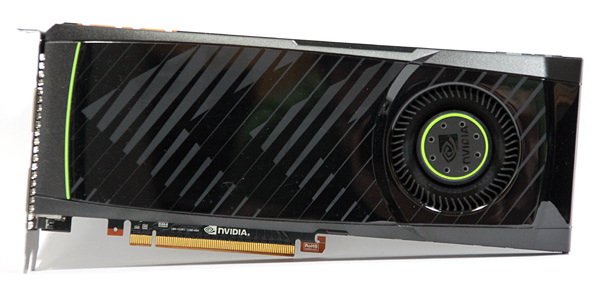Index
Page 1 of 8

Review: Fastest single GPU around, quiet too
Nvidia has a mid-life kicker. It is called Geforce GTX 580 and the card as we said before is based on a “new” improved GF100 chip that now bears the GF110 moniker. In reality is a GF100 done right, with some optimisation on the transistor level and the card itself has a new vapour chamber cooler that is really quiet, at least for a high-end card.
Does it really deserve the Geforce GTX 580 name? Well, continue reading and decide for yourself.
The card works at 772MHz while the shaders run at twice that clock, or 1544MHz. The card has 1.5GB of GDDR5 memory clocked to 2000MHz and paired up with a 384-bit bus. It is the same size as Geforce GTX 480 and it measures 10.5 inches or 26.67 centimeters in length. It has one 6-pin and 8-pin power connector and 244W TDP. The TDP is somewhat lower as the chip was slightly tweaked and the board has better power management. The TDP is also better as Nvidia redesigned the chip and introduced a new cooling solution to reference high end graphics cooling, the vapour chamber. It's worth noting that vapour chamber has been around for a couple of years, but it was usually reserved for non-reference boards. This is the first time we see it as part of the reference design.
The TDP is some 50W lower than on the old Geforce GTX 480. Nvidia didn’t talk about size of the core in square milimeters, but it should be very close to the original GF 100 core, so around 500mm2 sounds about right.
We can only cut the card in half and measure it, but since we have only one sample, we probably won't do it.
The transistor count is around 3 billion. Once again Nvidia doesn’t talk about the real number, probably in order to hide some things, like the fact that the chip has 512 shaders and all eight clusters turned on, the same number as it was possible on a fully enabled GF100 chip.
Nvidia took care of leakage on the transistor level, something that was responsible for many performance and temperature related issues and managed to gain some performance by increasing the clock. Nvidia also talked about the fact that you should see this new chip as a merger of some architectural advantages of the GF104 and GF100, and this was the formula that resulted in the GF110.
The video engine didn’t change, it is the same as on GF100, Fermi chips. You still have maximum of two display supported, no DisplyPort, at least not on reference boards. The reference card has two DVI ports and a mini HDMI. The mini HDMI cable might be bundled by partners and if not it will cost you much more than a standard full size HDMI that you use for your HD TV. Let's hope that Nvidia can control this otherwise we see little use of mini HDMI.
Nvidia couldn’t put the full size HDMI port as it didn’t have enough space on back of the part. One slot is reserved for the connectors, while other one is used as a blow out metal grille that is very important for Nvidia's new cooler. You could use a mini HDMI dongle to get a proper HDMI port, but the other downside for some users will be the fact that Nvidia only supports HDMI 1.3 and not later standards. Clearly consumers deserve to get HDMI and DisplayPort on any high-end card and we're not trhilled by the lack of the latter.
The video engine will most likely change on the other 500 series cards such as the GTX 560 but this is something that we need to wait and see. For this chip it was too risky to meddle with that as changing more parts of the chips on a new design that simply has to succeed is very dangerous, especially when you report to Jen Hsun Huang.
There are two more things related to the card itself, something that we haven't seen before. First is the new power current regulation with two circuits and these circuits regulate the speed of the fan much more preciously than before. In previous designs the GPU temperature was the key element in fan speed regulation and with this innovation Nvidia can get smoother fan control.

This also helps the vapour chamber cooler, one of the cool features of this new card. The principle is simple, there is a chamber full of a water-like liquid that evaporates and transfers the temperature from the GPU. Once the gas cools, it drops down to the GPU again and starts all over. It's basic physics, but it works.
Heatpipes are gone and vapour chamber looks like a more efficient way to cool the card. As a result of this the metal plate is gone and the cards temperature dropped from an average 94 degrees Celsius on the GTX 480 to 84 Celsius with GTX 580. You can now touch the card and not get burned, which is a great improvement over the GTX 480.
Since the card doesn’t have metal plate it is lighter and won't easily break the PCIe slot in transport, but of course this dual-slot card is still quite heavy.
We have been waiting for a long time to see technologies similar to water cooling and vapour chamber in GPU cooling. Basically GPU development has come to the point that air coolers and heatpipes are not simply enough, they simply needed more performance.
Prev Next »



